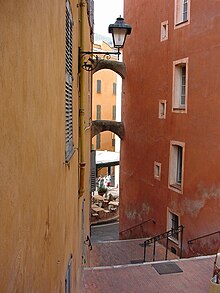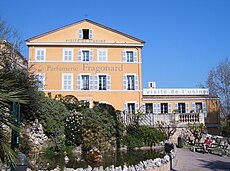Grasse
| Grasse | ||
|---|---|---|

|
|
|
| region | Provence-Alpes-Cote d'Azur | |
| Department | Alpes-Maritimes | |
| Arrondissement | Grasse | |
| Canton |
Grasse-1 Grasse-2 |
|
| Community association | Pays de Grasse | |
| Coordinates | 43 ° 39 ′ N , 6 ° 56 ′ E | |
| height | 80-1,061 m | |
| surface | 44.44 km 2 | |
| Residents | 50,396 (January 1, 2017) | |
| Population density | 1,134 inhabitants / km 2 | |
| Post Code | 06130 | |
| INSEE code | 06069 | |
| Website | www.ville-grasse.fr | |
 Grasse "from above" |
||
Grasse is a French commune in the Alpes-Maritimes department with 50,396 inhabitants (as of January 1, 2017). It is considered the world capital of perfume and achieved worldwide fame as the setting for the novel Das Parfum by Patrick Süskind .
geography
Grasse extends in the hill country of the southern foothills of the Maritime Alps to an average of 306 m above sea level (altitude between 80 and over 1,061 m), about 20 kilometers north of Cannes on the Côte d'Azur . In the direction of Digne-les-Bains, the former Route nationale 85 passes , the so-called Route Napoléon (Napoleon Road), which follows the route that Napoléon took on his march to Paris in 1815 after his return from Elba.
history
Grasse was first mentioned in 1040. In 1227 Count Raimund Berengar V of Provence conquered the city and it became part of Provence .
Grasse was the seat of a bishopric from the 13th to the 18th century .
When the départements were created in 1790, Grasse was still part of the Var département , the administrative seat of which it was from 1793 to 1795.
In 1860 the arrondissement was combined with the county of Nice to form the Alpes-Maritimes department .
In the 19th century, Grasse became a health resort, but in the 20th century it lost its importance again to the preferred coastal towns.
Population development
| year | 1962 | 1968 | 1975 | 1982 | 1990 | 1999 | 2006 | 2017 |
| Residents | 26,258 | 30,907 | 34,579 | 37,673 | 41,388 | 43,874 | 48,801 | 50,396 |
| Sources: Cassini and INSEE | ||||||||
coat of arms
Description ( blazon ): In blue a retrospective gold-nimbed silver Agnus Dei , with the raised left front leg holding a shouldered, cross-terminated red pole with a silver banner with a red cross (flag of victory) that ends in two corners, accompanied by two in the Upper corners and a red disc placed in the center of the base of the shield.
Town twinning
The following cities are siblings with Grasse:
|
|
Ingolstadt | Germany | since May 7, 1963 |
|
|
Opole | Poland | since October 1964 |
|
|
Vila Real | Portugal | since May 1975 |
|
|
Pardes Hanna-Karkur | Israel | since October 1985 |
|
|
Marblehead | Mass. , USA | since June 1986 |
|
|
Murcia | Spain | since May 1990 |
|
|
Carrara | Italy | October 2000 |
The city is also a member of the Federation of European Napoleonic Cities .
Economy and Infrastructure
In the Middle Ages, Grasse was a city republic with an old commercial tradition, in particular the tanning trade was very widespread. When the fashion to perfume gloves emerged around 1600, the distillation of fragrances was shifted here . Since the 17th century, the perfumers from Grasse have specialized in the extraction of flower juice, especially for orange blossoms and jasmine . The sideline became the main business, and it has remained so to this day.
The flower plantations around Grasse, which were characteristic of the past, have become rare today, as flowers are mostly imported from cheap growing countries such as Morocco , Bulgaria , India or Turkey . The fragrances obtained in the perfume industry are used in addition to perfume for cosmetics, detergents, washing powder and for food flavorings. In 2004, around 4,000 people were employed in the perfume industry in Grasse. 10,000 tons of flowers were processed annually.
Today (as of 2010), international economic relationships are particularly cultivated in Grasse. The raw materials treated in Grasse are imported from many parts of the world and are qualitatively refined here. About 30 perfume factories in and around Grasse then send their products all over the world.
Established businesses
The most famous perfume factories that offer free tours in multiple languages of their historic production sites are the Fragonard , Galimard , Molinard , Fleuron de Grasse and Guy Bouchara perfumeries . The fragrance and flavor manufacturer Robertet is listed and part of the French CAC Small index.
Attractions
See also: List of the Monuments historiques in Grasse
- Notre-Dame-du-Puy cathedral in Grasse : The cathedral dates from the 12th century. It has a simple style, its structure reflects the Lombard influences. It contains paintings by Rubens , Charles Nègre and a triptych by Louis Bréa as well as the only religious painting by Jean-Honoré Fragonard , “The Washing of the Feet ”.
- Gardens: Grasse is known for its gardens, which were even more extensive in earlier times. One of the most famous is the 'Jardin des Plantes'. This garden owes its fame to Napoleon's sister , who used to relax there in winter. The garden offers a good overview of the old town and the sea.
- In the flower fields of the Domaine de Manon , the perfume specialists cultivated the plants for the local perfume production. These flower fields are located in a hamlet outside Grasse, ten minutes from the city center.
- Naval Museum: The 18th century museum is dedicated to François-Joseph Paul Graf von Grasse (1722–1788), a great navigator of the time. Over 30 model ships are on display in the house.
- International Museum of Perfumery ( Musée internationale de la Parfumerie ): The Perfumery Museum is also located in an originally furnished house from the 18th century and shows a collection of porcelain and a large collection of perfume bottles ; it was reopened at the end of 2008 after a four-year renovation period.
- Museum of Provencal Art and History (Musée d'Art et d'Histoire de la Provence): The museum was set up in one of the most elegant noble residences of the 18th century in Grasse, the old mansion of the Marquise of Clapiers Cabris, Mirabeau's sister . Together with its furnishings, the exhibition of earthenware, paintings, costumes, nativity figures and other things gives an impression of daily life in eastern Provence, from prehistory to the 1950s.
Leisure and Tourism
- Guided tours of the old town: The tourist office offers guided tours through the old town with various themes (for groups all year round).
- Perfume factories tours: The perfume factories (see above) offer free multilingual tours all year round.
- Day trips for example to Cabris , Cannes , Saint-Paul-de-Vence
- Hikes in the Maritime Alps
Regular events
- Expo Rose: the 'Expo Rose' exhibition shows 40,000 different roses and products made from them every year in mid-May. The most frequented streets of the city are also sprayed with the scent of roses.
- Jasmin Festival (Fête du Jasmin): The Jasmin Festival is a folk festival at the beginning of the jasmine blossom harvest. It takes place annually at the beginning of August.
Culinary specialties
Specialties for Grasse and the surrounding area are:
- Lou Fassum (Chou farci), a cabbage pie
- Les beignets de fleurs de courge, deep-fried pumpkin blossoms in a batter, which are part of the thirteen-course Christmas menu as a dessert
- Le Fougassette, a yeast cake with an orange flavor
traffic
A bus system is available that offers a circuit in Grasse itself as well as various connections to neighboring villages and cities, for example Cannes and Nice . There is also a train station on the Cannes – Grasse line .
Personalities
Sons and daughters
- Jean-Honoré Fragonard (1732–1806), painter
- Honoré Fragonard (1732–1799), anatomist
- Marguerite Gérard (1761–1837), painter
- Honoré Théodore Maxime Gazan de la Peyrière (1765–1845), French general of the coalition wars
- Alexandre-Évariste Fragonard (1780–1850), French painter and sculptor
- Charles Nègre (1820–1880), painter and photography pioneer
- Robert Crépeaux (1900–1994), chess player
- Charles Pasqua (1927-2015), French politician
- Robert Nyel (1930–2016), French singer, composer and draftsman
- Didier Malherbe (* 1943), jazz and fusion musician
- Michèle Mouton (* 1951), French rally driver
- Daniel Goyone (* 1953), jazz and fusion musician
- Pierre-Louis Lions (* 1956), mathematician
- Marion Bertrand (* 1984), French ski racer
- Eugénie Le Sommer (* 1989), football player
- Vincent Koziello (* 1995), football player
People with a relationship to the city
- Hans Arp (1886–1966), German-French painter, sculptor and poet, found refuge from the Nazis in Grasse from 1940 to 1942 together with his wife Sophie Taeuber
- Kay Boyle (1902–1992), American journalist and writer, lived and worked with Ernest Walsh, editor of “This Quarter”, in Grasse in 1926, until the latter died a year later
- Iwan Bunin (1870–1953), Russian writer and Nobel Prize laureate, spent several years of his exile (1939–1945) in Grasse, where he wrote his collection of love stories "Dark Aleen"
- Augustin Grimaldi (1482–1532), Bishop of Grasse, later Prince of Monaco
- Ferdinand Springer (1907–1998), German painter and graphic artist, lived, worked and died in Grasse
- Sophie Taeuber-Arp (1889–1943), Swiss painter, sculptor and dancer, spent the last years of her life with her husband Hans Arp, on the run from the Nazis, in Grasse
See also
- Perfume - The Story of a Murderer is the title of a 1985 novel by Patrick Süskind . One of the locations of the novel is Grasse.
- Film: Adaptation of Patrick Süskind's 2006 novel under the title Perfume - The Story of a Murderer , directed by Tom Tykwer . With Ben Whishaw , Dustin Hoffman , Alan Rickman and others. The film has won several awards.
literature
- Le Patrimoine des Communes des Alpes-Maritimes . Flohic Editions, Volume 1, Paris 2000, ISBN 2-84234-071-X , pp. 372-398.
Web links
- Page from Grasse (French, English)
Individual evidence
- ↑ Homepage Grasse - Jumelages , accessed on June 13, 2016






